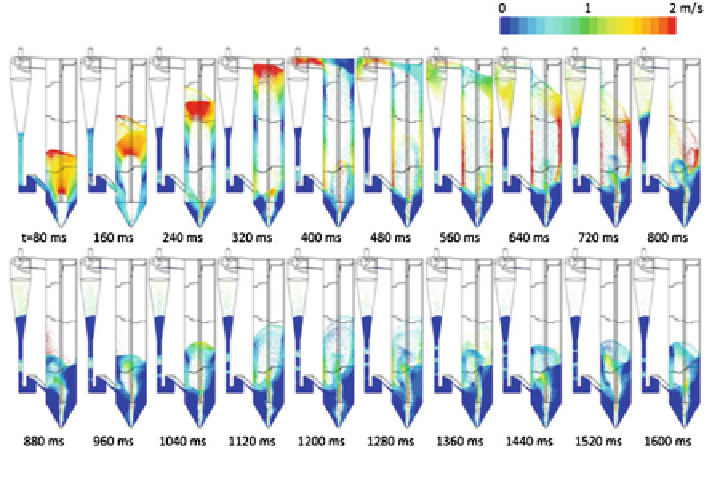Environmental Engineering Reference
In-Depth Information
formed by the reaction in order to track the reaction progress without the small mass
fractions of generated CO
2
being overshadowed by the injected CO
2
. The aeration
in the downcomer and the loop seal is non-reacting and comprises solely of N
2
.
This helps to identify the recirculation of particles from the loop seal to the fuel
reactor; the particles that originate in the loop seal will have a smaller mass fraction
of Fe
3
O
4
since they were initially exposed to inert N
2
. Based on preliminary trials to
investigate the momentum transfer to the particles, the velocity of the central jet and
the aeration velocity in the loop seal are set at 60 and 2 m/s, respectively. All other
parameters in the simulation remain unchanged from the cold
flow simulations
reported in the previous sections. The particle distributions and velocities are
inspected at 80-ms intervals and presented in Fig.
18
for the
fl
first 1,600 ms of
fl
ow
injection.
The particle tracks in Fig.
18
show the same initial behavior as in the cold
fl
ow
case (see Fig.
16
); the
first gas bubble reaches the top of the reactor around 400 ms
and deposits a large number of solid particles into the cyclone. Between 480 and
880 ms, the pressure buildup in the fuel reactor vanishes and the remaining particles
in the fuel reactor fall back into the
fluidized bed, while the particles in the cyclone
fall into the downcomer. Continuous recirculation of solid particles from the loop
seal back into the fuel reactor is also evident. Once the particles start to settle back
into the
fl
fluidized bed and aided by the recirculation of particles from the loop seal,
the pressure buildup due to the jet injection is partially restored and subsequent gas
bubbles are formed around 960 ms and 1,440 ms. However, in these cases, the
kinetic energy transferred to the particles is insuf
fl
cient to carry them to the top of
the reactor and the bubbles collapse prematurely. This can be explained by the
Fig. 18 Particle tracks colored by velocity magnitude in reacting
fl
ow

Search WWH ::

Custom Search